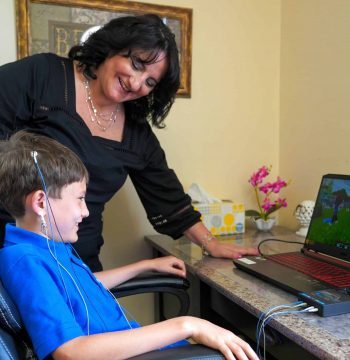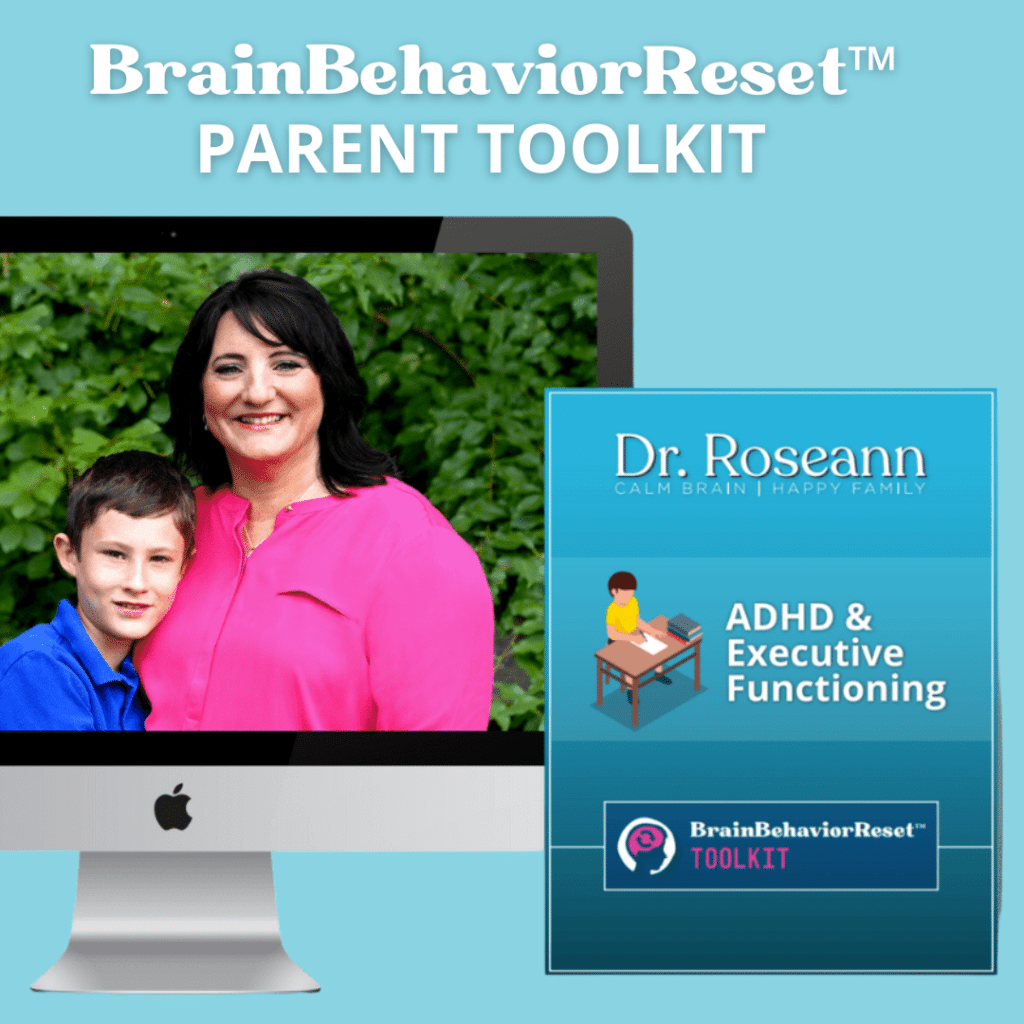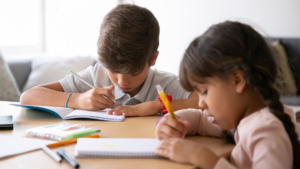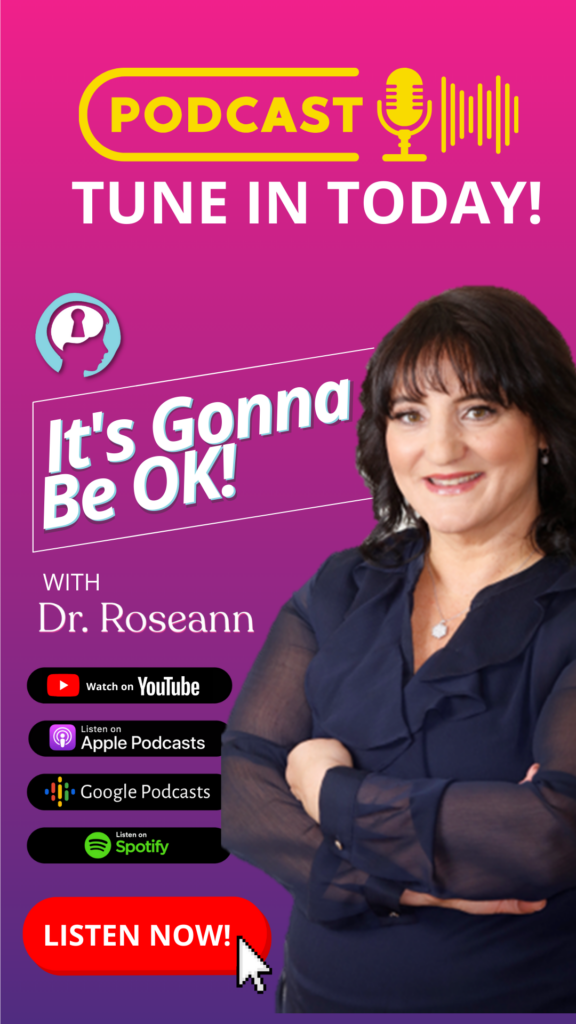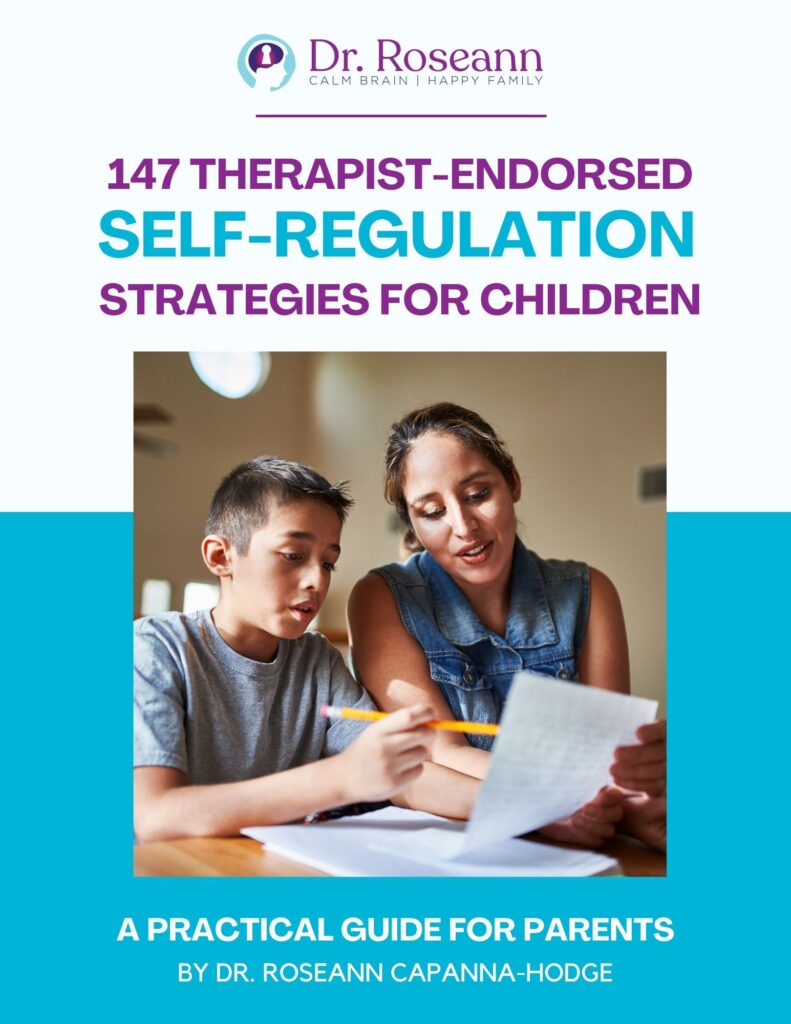Nationwide, 20% of the elementary school population is struggling with reading while one in five students has a language-based learning disability. Currently, 80% of children with an IEP have reading difficulty, 85% of whom are diagnosed with dyslexia, a language-based learning disability.
What is Dyslexia?
As a language-based learning disability, dyslexia most impacts one’s phonics and reading skills. The International Association of Dyslexia definition of Dyslexia states “Dyslexia is a specific learning disability that is neurobiological in origin. It is characterized by difficulties with accurate and/or fluent word recognition and by poor spelling and decoding abilities. These difficulties typically result from a deficit in the phonological component of language that is often unexpected in relation to other cognitive abilities and the provision of effective classroom instruction. Secondary consequences may include problems in reading comprehension and reduced reading experience that can impede growth of vocabulary and background knowledge.”
It is important to recognize that dyslexia aggregates a variety of symptoms into an overarching disability that leads to difficulties with both oral and written language. Children can present dyslexia with numbers, letters, phonics, and writing. Moreover, since dyslexia’s impact can change over time, children who are not diagnosed early may learn inappropriate coping mechanisms or executive functioning difficulties that makes diagnosing it more difficult as they grow older.
What are the Types of Dyslexia?
While most people think there are types of dyslexia, there aren’t. Rather, dyslexia impacts readers in different ways but is always phonological in nature. Dyslexics have a foundational issue in phonological awareness, phonological memory, or with rapid language retrieval that impact their phonics and reading skills.
In the past, types of Dyslexia included Surface Dyslexia, Visual Dyslexia, Rapid Naming Deficit, and Double Deficit Dyslexia but know we know that Dyslexia is phonological in basis, which is the inability to break down sounds. There is still a belief that dyslexia involves a visual processing problem due to the common problem of reversing letters.
Dyslexics reverse letters because their brain is not accurately hearing the sounds; so when an individual goes to map the sound (phoneme) to that letter (grapheme), it doesn’t match up. That doesn’t mean that dyslexics don’t have visual processing or issues with the eye itself (e.g., eye convergence etc.). Ensuring that your child is appropriately diagnosed means the specific areas that need to be remediated are identified.
What are Some Early Dyslexia Symptoms?
There are definite early signs of dyslexia in young children that shouldn’t be ignored. The signs of dyslexia in a 5 year old and the signs of dyslexia in a 7 year-old can differ greatly since the older child may be showing problems at school due to increased reading expectations.
However, if a parent is aware of the early signs, then they can try to find appropriate supports sooner, as early intervention is critical for life success. If you have an older child, these are important things to note if they occurred in their history.
Lacks Phonetic Skills
Children with Dyslexia often lack phonetic skills becuase of their auditory dyslexia and therefore have poor word attack skills. Contrary to popular belief, dyslexia is not a visual processing disorder but a language-based learning disorder. Children reverse the sounds, not the letters, which creates a disconnect between the two. In other words, they can’t accurately “hear” the sounds so they can’t map them to the letters. All readers need phonetic decoding skills and a lack of these skills may be a red flag.
Displays Early Learning Difficulties
Many children with dyslexia displayed early learning difficulties, such as problems learning colors, letter, or numbers despite good intelligence and often strong oral language skills. Children with dyslexia often have a history that includes articulation, speech, or language difficulties.
Has Difficulty with Rhyming
Children with dyslexia often have a specific difficulty with oral rhyming. Most identifiable at a young age, they have difficulty responding to questions such as, “What rhymes with cat?” Additionally, they can’t recognize rhyming patterns like cat, mat, hat. Sounding out simple words may be very difficult for them. Their difficulty mapping sounds to letters makes speech a laborious process for dyslexic children.
What Symptoms of Dyslexia Show as Children Age?
Early signs of dyslexia may make it difficult to determine until more reading demands are placed on children. As children move through the school system, additional red flags may appear. They may avoid or dislike reading, fall behind peers, or show an inconsistent learning pattern in reading.
Attention difficulties and executive functioning issues may further complicate the problem. Children and teens with dyslexia typically have problems with reading comprehension and writing due to increasing language demands that require a high level of coordinated skills regulated by the executive functions of the brain. In particular, writing requires a tremendous amount of executive functioning that regulates all those language, phonetic, spelling, and planning skills required to get your thoughts down on the page.
Signs of Dyslexia in Kids
Reading problems in both girls and boys show up in the same way. One difference is that dyslexia in girls may be missed because girls show less behavioral issues then when there is dyslexia in boys.
We often talk about levels of dyslexia in children: from mild dyslexia to moderate dyslexia and more severe dyslexia. All dyslexics show signs of dyslexia early with problems with phonics being the primary issue. Symptoms of being dyslexic are often masked by good intellect and memorizing the words without having decoding skills.
Early Signs: Dyslexia in Preschoolers and Young Children
Even before children begin formal schooling, signs of dyslexia can emerge. It's crucial for parents to be vigilant during these formative years, as early intervention can make a significant difference:
- Delayed Speech: While each child's development is unique, a marked delay in speech could be an early sign of dyslexia.
- Difficulty with Rhymes: If a preschooler struggles to understand or engage with rhymes, this could be a red flag.
- Challenges in Letter Recognition: By age 5, most children begin to recognize some letters, especially those in their name. A difficulty in this area might be indicative of a greater issue.
- Mispronouncing words, such as “beddy tear” instead of “teddy bear”
- Struggling to name familiar objects, using general words like “thing” or “stuff”
- Difficulty learning nursery rhymes or song lyrics that rhyme
- Trouble remembering sequences, like the letters of the alphabet
- Telling stories in a hard-to-follow manner or talking about an event out of order
- Difficulty following multi-step directions
Signs of Dyslexia in a 5 Year Old – Grades K-2
- Trouble learning letter names and remembering their sounds
- Often confusing letters that look similar (e.g., b, d, p, q) or sound similar (e.g., f and v, b and p)
- Struggling to read familiar words (like “cat”), especially without pictures
- Substituting words when reading aloud
- Difficulty separating individual sounds in words and blending sounds
- Inconsistent spelling and difficulty applying spelling rules
Dyslexia in 6-year-olds
Early Language Development: Delays in speaking or acquiring vocabulary, difficulty in pronouncing words (dyslexic pronunciation), or confusing words that sound similar.
Letter Recognition: Struggles with recognizing and remembering letters, which is sometimes referred to as ‘letter blindness', though this term is not typically used by professionals.
Phonemic Awareness: Difficulties in learning to match letters to sounds, which is a cornerstone of reading. Children may show confusion with rhyming or blending sounds to make words.
Parents and educators should note these early indicators and consider a dyslexia test or assessment if concerns persist. Recognizing dyslexia early can lead to beneficial interventions, such as phonics-based reading instruction and speech therapy if necessary.
Signs of Dyslexia in a 7 Year Old
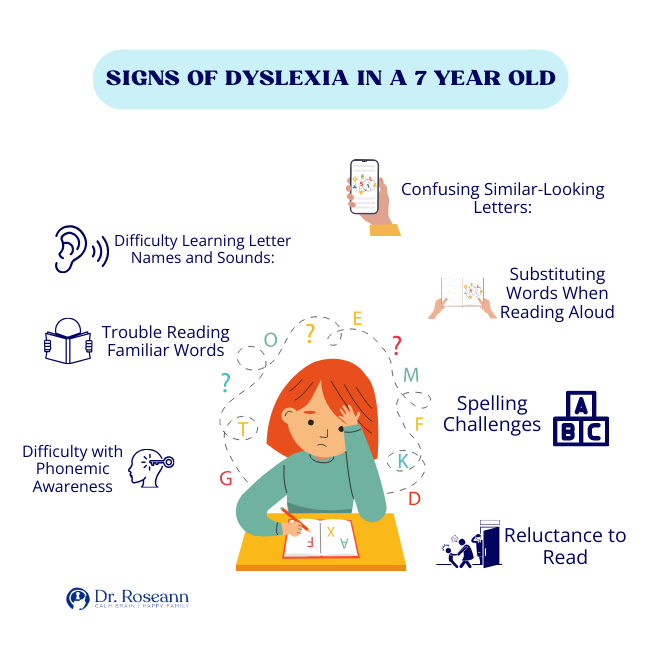
At around 7 years old, which typically corresponds to first or second grade, children with dyslexia may exhibit various signs. It's important to remember that each child is unique, and not all children will show all of these signs.
Common signs of dyslexia in 7 year olds may include:
- Difficulty Learning Letter Names and Sounds: They might struggle to remember the names of letters and the sounds they represent.
- Confusing Similar-Looking Letters: They often mix up letters that look alike, such as ‘b', ‘d', ‘p', and ‘q', or those that sound similar, like ‘f' and ‘v', or ‘b' and ‘p'.
- Trouble Reading Familiar Words: They may find it challenging to read simple, familiar words, especially if there are no pictures to provide context.
- Substituting Words When Reading Aloud: They might say a different word that has a similar meaning when reading a text, such as saying “house” instead of “home”.
- Difficulty with Phonemic Awareness: This includes problems separating the individual sounds in words and blending sounds together to form a word.
- Spelling Challenges: They often have trouble remembering how words are spelled and applying spelling rules. Their spelling might be inconsistent, even within the same writing exercise.
- Reluctance to Read: They might show a general avoidance of reading activities, often due to frustration or lack of confidence in their reading abilities.
These signs can be indicators of dyslexia, but they can also reflect poor instruction. Therefore, if a child shows several of these signs consistently, it may be beneficial to seek an evaluation from an educational professional or a specialist in learning disabilities for a proper assessment and guidance.
Signs of Dyslexia in a 9 Year Old: Grades 3-5
- Confusing or skipping small words like “for” and “of” when reading aloud
- Trouble sounding out new words
- Difficulty quickly recognizing common sight words
- Struggling to explain a story or answer questions about key details
- Frequently making the same kinds of mistakes, like reversing letters
- Consistently poor spelling
- Avoiding reading or getting frustrated/upset when reading
Signs of Dyslexia in Middle Schoolers – Ages 12 -14
- Trouble expressing ideas clearly and logically
- Difficulty learning foreign languages
- Challenges understanding humor and nuanced language
- Difficulty with spatial concepts, like reading charts and graphs
- Repeatedly needing to read material to understand it
- Extreme difficulty managing homework and tracking assignments
- Unexpected trouble with higher math, such as algebra
Signs of Dyslexia in Teens: High School – Ages 15- 18
- Poor reading skills despite normal intelligence
- Problems with executive functioning
- Poor spelling and writing skill
- Advoidance of writing
- Trouble finishing assignments and tests within time limits
- Difficulty remembering the right names for things
- Problems memorizing lists and phone numbers
- Challenges with directions or reading maps
- Struggling in foreign language classes
Reads Below Grade Level
If your child is trailing behind their peers in reading, something is wrong. However, finding the answer is more difficult. Children can fall behind grade level without proper instruction. However, they can also have a physical problem such as issues with sight or oral low tone. In some cases, a child may not be developmentally ready to read.
If your child only progresses with extra help and the moment it is removed, they backslide, then a problem exists. Your child could be dyslexic. Only a thorough evaluation can answer why they are having a reading problem.
Gets Extra Reading Help in Early Grades
If your child is getting early reading help in Kindergarten or first grade, you should be very concerned because that means phonological processing is not happening automatically for them. The early grades focus on learning sounds so children can map them to the letters. If your child struggles with interpreting the sounds correctly, then how can they learn to read.
While most parents are thrilled that their child is getting reading help and often note improvements, they need to make sure their child is getting the right kind of help to create a strong foundation for reading. Often, parents don’t realize how important those early reading interventions are until their child is sinking in the later grades when independent reading is required.
Receives Summer Reading Help
Is the same way you should be worried about if your child had early reading help, you should be worried if your child has been red flagged for summer reading or extended school reading (ESY) assistance. A school recommending summer reading help isn’t typical and that means your child is behind. Summer reading help can be phenomenal, but for dyslexics, it needs to be a structured, multi-sensory reading support in a formal, sequential manner. For decades, that is what the research has shown us what works.
Tanks in Third Grade
This is the year where children are no longer learning to read and now must read to learn. Children with dyslexia often have above average IQ’s and can compensate pretty well until they must read independently. Depending on their compensatory skills, some children sharply decline in third grade while others decline more gradually. If you have a 2nd grader struggling to read, don't delay.
Unfortunately, many people believe that children with a suspected reading disability shouldn’t be tested until third grade or that dyslexia is hard to diagnose nor is it ever too early to diagnose dyslexia. Therefore, they respond after the child starts to fail rather than creating a proactive program.
As soon as you suspect your child has a reading difficulty get them evaluated by a highly trained and qualified professional. A dyslexia test that looks at specific areas of phonological processing deficits is often not administered but should be so a clear treatment plan can be made.
We use QEEG brain maps as part of our intake process to help identify areas of the brain that are overworking and underworking and then make a treatment plan with neurofeedback to help speed processing and improve reading skills.
Hates Reading
Many children with dyslexia hate reading and resist it. The irony is these are often very bright and inquisitive children with strong mechanical skills. Parents will often tell me that these same reading resisters love to be read to. Reading is hard for them and without proper instruction in a manner that unlocks their learning, they’ll avoid it.
Family History of Dyslexia
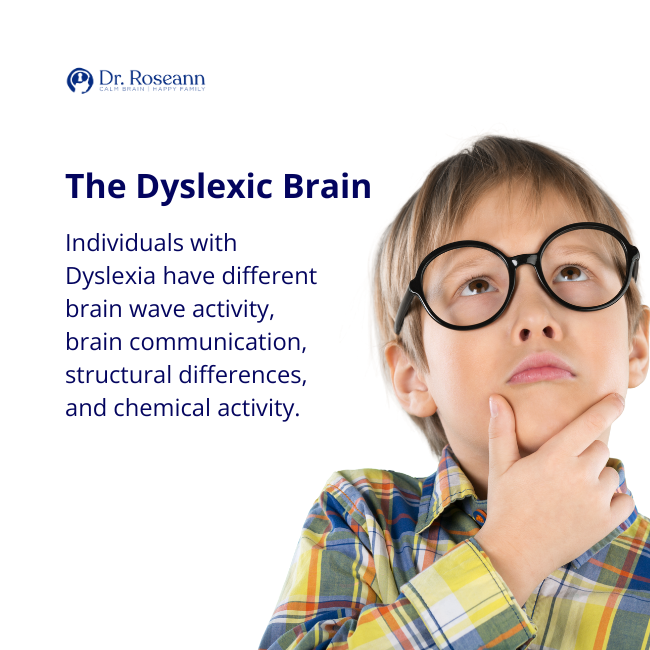
Dyslexia runs in families. In all my years of working with a child or adult with dyslexia, I have never had one individual that didn’t at least have a family member with suspected Dyslexia. A family history of language-based learning disability, reading disorder or dyslexia is a definate risk factor for phonological dyslexia.
Research demonstrates that the brains of individuals with Dyslexia are different. Causes of dyslexia are differences in brain structure and environmental factors can help or worsen a child's ability to read.
It has been found that individuals with Dyslexia have different brain wave activity, structural differences, and chemical activity. Their brain communication hubs don't work efficiently. That is why so many dyslexics benefit from neurofeedback, which improves processing speed and brain communication.
Handwriting Signs of Dyslexia
Dysgraphia, often associated with dyslexia, can affect handwriting and motor skills:
-
Irregular Handwriting: Look for writing that is uneven or varies in size and shape (‘sequential spelling'). There may be a mix of cursive and print styles within the same word or sentence (‘bendy pencils'), and letters may be written in reverse (‘show and tell with letter x').
-
Spacing and Organization: Children might struggle with the spacing between words and letters, leading to cramped or scattered writing. The organization of written work on the page may also be impacted, with text appearing disordered or misaligned (‘how to write check amount in words').
-
Spelling Inconsistencies: Even with common words (‘words for bad'), spelling may be unpredictable and inconsistent. There may be frequent errors in simple words while occasionally getting more complex words correct (‘diagnose spelling').
For both educators and parents (‘profile girl', representing caregivers and teachers), understanding these signs can be critical. It’s not just about the clarity of handwriting but also about how these patterns reflect the underlying language processing challenges of dyslexia (‘dyslexic meaning', ‘dyslexia symbol').
Living with Dyslexia: Strategies and Support
Education and Intervention:
Early intervention is crucial, and with the right support, individuals with dyslexia can achieve success academically and professionally. This involves structured literacy programs that emphasize phonemic awareness, phonics, fluency, vocabulary, and comprehension strategies. Accommodations such as extra time on tests, oral exams, or the use of technology can also assist in managing dyslexia.
Technology and Tools:
The digital age has brought numerous assistive technologies to help those with dyslexia. Text-to-speech software, spell-checkers, and apps designed to support reading and writing can be invaluable tools. Online dyslexia tests and resources also offer accessible ways for individuals to seek help and understand their learning profile.
Advocacy and Awareness:
Educating peers, educators, and employers about dyslexia is essential. Dyslexic individuals often possess unique skills in problem-solving, creativity, and holistic thinking—traits that are beneficial in many contexts. Creating a supportive environment where the focus is on strengths rather than challenges can make a significant difference.
By understanding the multi-faceted nature of dyslexia and recognizing that it manifests differently across ages and individuals, we can foster an environment that promotes the growth and success of those with dyslexia. It’s not a question of seeing words or letters backward, but understanding that dyslexia affects how information is processed, interpreted, and retrieved.
What to do When You Have a Dyslexic Child
Understanding the signs of dyslexia and acting on them is critical to supporting the dyslexic child to ensure success today and in the future. While neurodivergence is becoming the norm, children with a learning disability need direct intervention and support.
As my friend, Pete Wright from wrightslaw.com and special education attorney gouru always talks about, kids with a dyslxia learning disability need dyslexia treatment.
Over the years, I have helped many dyslexics get dyslexia treatment in our BrainBehaviorReset Program, where we calm and regulate the brain with neurofeedback and come in with new learning. When you have a language based learning disability, getting proper help is key and that is how Kat used our program to overcame her dyslexia.
Read my blog on 10 Ways to Help Your Dyslexic Child to learn more about supporting your child. Remember that there is no medication for dyslexia and that supporting their brain to work more optimally and getting proper instruction is key. Getting reading help at home is important too.
Dr. Roseann Capanna-Hodge is a mental health expert in Dyslexia and parenting who is frequently featured in the media:
- Parents I'm a Mom and a Teacher: Here's How I'm Talking to My Students About the Attack at the Capitol
- The Creative Clinician's Corner (Article) Helping Parents Get Unstuck
- The Washington Post Parenting through pandemic decision fatigue
- The Week Best Parenting Advice
- The Week Why does my kid have to win all the time?
- The Week Why is my kids so annoying?
- Brentwood Home Dos & Don'ts for Creating a Child's Workstation at Home
Citations:
de Bree, E. H., van den Boer, M., Toering, B. M., & de Jong, P. F. (2022). A stitch in time…: Comparing late-identified, late-emerging and early-identified dyslexia. Dyslexia (Chichester, England), 28(3), 276–292. https://doi.org/10.1002/dys.1712
Snowling M. J. (2013). Early identification and interventions for dyslexia: a contemporary view. Journal of research in special educational needs : JORSEN, 13(1), 7–14. https://doi.org/10.1111/j.1471-3802.2012.01262.x
Snowling, M. J., & Melby-Lervåg, M. (2016). Oral language deficits in familial dyslexia: A meta-analysis and review. Psychological bulletin, 142(5), 498–545. https://doi.org/10.1037/bul0000037 aSy
Always remember… “Calm Brain, Happy Family™”
Looking for more support for your child at school? Grab your complimentary copy of
The Ultimate Guide to School Accommodations to Become Your Child’s Best Advocate
Are you looking for SOLUTIONS for your struggling child or teen?
Dr. Roseann and her team are all about science-backed solutions, so you are in the right place!
Dr. Roseann is a Children’s Mental Health Expert and Licensed Therapist who has been featured in/on hundreds of media outlets including The Mel Robbins Show, CBS, NBC, PIX11 NYC, Today, FORBES, CNN, The New York Times, The Washington Post, Business Insider, Women’s Day, Healthline, CNET, Parade Magazine and PARENTS. FORBES called her, “A thought leader in children’s mental health.”

She coined the terms, “Re-entry panic syndrome” and “eco-anxiety” and is a frequent contributor to media on mental health.
Dr. Roseann Capanna-Hodge has three decades of experience in working with children, teens and their families with attention-deficit hyperactivity disorder (ADHD), autism, concussion, dyslexia and learning disability, anxiety, Obsessive Compulsive Disorder (OCD), depression and mood disorder, Lyme Disease, and PANS/PANDAS using science-backed natural mental health solutions such as supplements, magnesium, nutrition, QEEG Brain maps, neurofeedback, PEMF, psychotherapy and other non-medication approaches.
She is the author of three bestselling books, It’s Gonna Be OK!: Proven Ways to Improve Your Child's Mental Health, The Teletherapy Toolkit, and Brain Under Attack. Dr. Roseann is known for offering a message of hope through science-endorsed methods that promote a calm brain.
Her trademarked BrainBehaviorResetⓇ Program and It’s Gonna be OK!Ⓡ Podcast has been a cornerstone for thousands of parents facing mental health, behavioral or neurodevelopmental challenges.
She is the founder and director of The Global Institute of Children’s Mental Health, Neurotastic™Brain Formulas and Dr. Roseann Capanna-Hodge, LLC. Dr. Roseann is a Board Certified Neurofeedback (BCN) Practitioner, a Board Member of the Northeast Region Biofeedback Society (NRBS), Certified Integrative Mental Health Professional (CIMHP) and an Amen Clinic Certified Brain Health Coach. She is also a member of The International Lyme Disease and Associated Disease Society (ILADS), The American Psychological Association (APA), Anxiety and Depression Association of America (ADAA) National Association of School Psychologists (NASP), International OCD Foundation (IOCDF).
© Roseann-Capanna-Hodge, LLC 2023
Disclaimer: This article is not intended to give health advice and it is recommended to consult with a physician before beginning any new wellness regime. *The effectiveness of diagnosis and treatment vary by patient and condition. Dr. Roseann Capanna-Hodge, LLC does not guarantee certain results.



